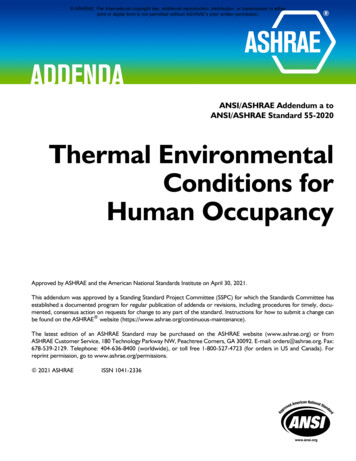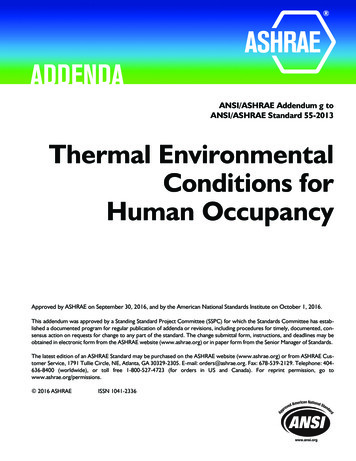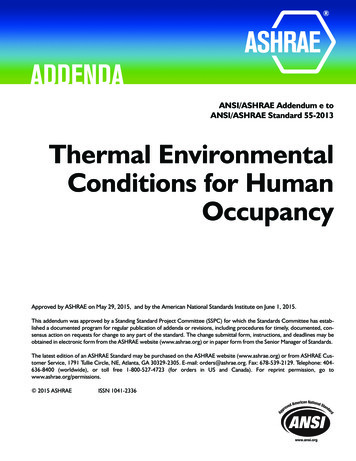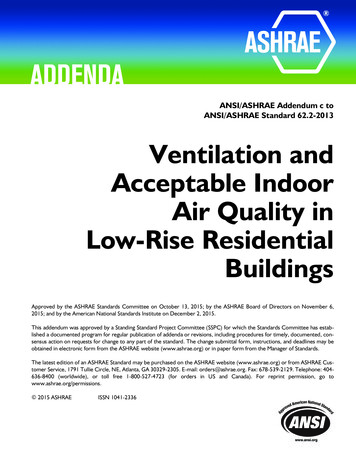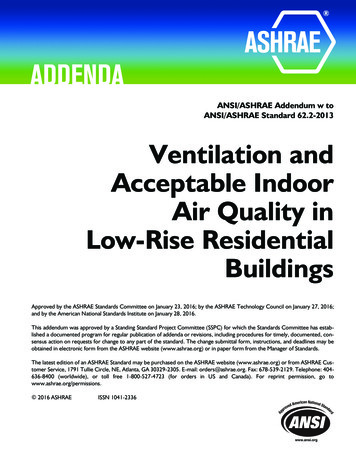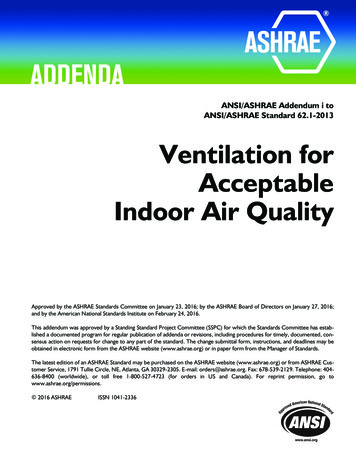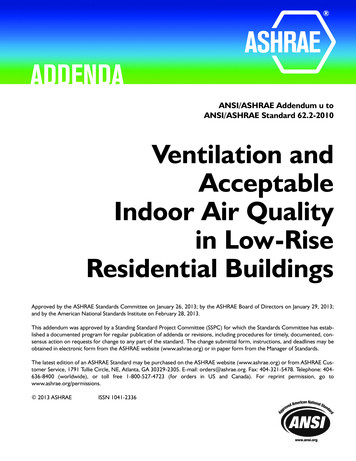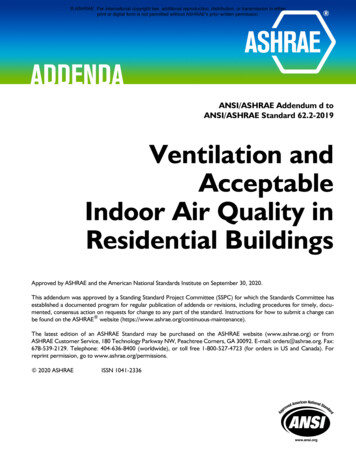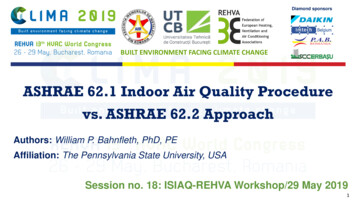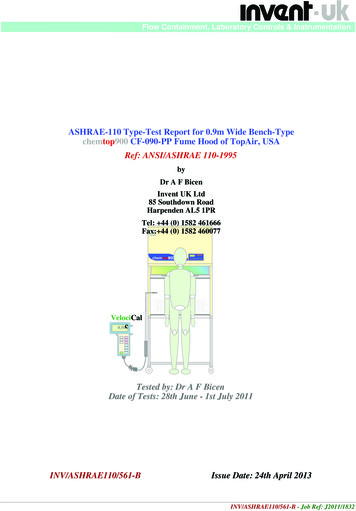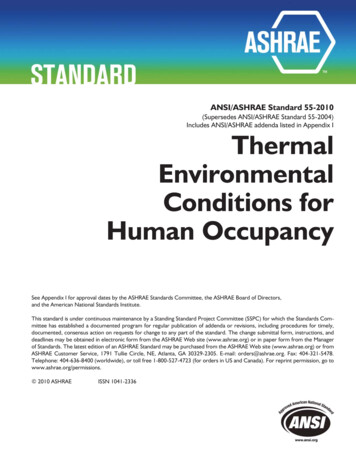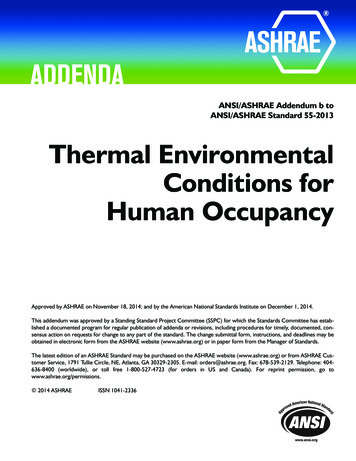
Transcription
ANSI/ASHRAE Addendum b toANSI/ASHRAE Standard 55-2013Thermal EnvironmentalConditions forHuman OccupancyApproved by ASHRAE on November 18, 2014; and by the American National Standards Institute on December 1, 2014.This addendum was approved by a Standing Standard Project Committee (SSPC) for which the Standards Committee has established a documented program for regular publication of addenda or revisions, including procedures for timely, documented, consensus action on requests for change to any part of the standard. The change submittal form, instructions, and deadlines may beobtained in electronic form from the ASHRAE website (www.ashrae.org) or in paper form from the Manager of Standards.The latest edition of an ASHRAE Standard may be purchased on the ASHRAE website (www.ashrae.org) or from ASHRAE Customer Service, 1791 Tullie Circle, NE, Atlanta, GA 30329-2305. E-mail: orders@ashrae.org. Fax: 678-539-2129. Telephone: 404636-8400 (worldwide), or toll free 1-800-527-4723 (for orders in US and Canada). For reprint permission, go towww.ashrae.org/permissions. 2014 ASHRAEISSN 1041-2336
ASHRAE (www.ashrae.org). For personal use only. Additional reproduction, distribution,or transmission in either print or digital form is not permitted without ASHRAE's prior written permission.ASHRAE Standing Standard Project Committee 55Cognizant TC: 2.1, Physiology and Human EnvironmentSPLS Liaison: John F. DunlapGwelen Paliaga, Chair*Lawrence J. Schoen, Vice Chair*Peter F. Alspach, Secretary*Sahar Abbaszadeh Fard*Edward A. Arens*Richard M. Aynsley*Robert Bean*Atze BoerstraGail S. BragerRichard de DearJosh Eddy*Thomas B. Hartman*Daniel Int-Hout, III*Michael A. HumphreysEssam Eldin Khalil*Baizhan LiBrian M. LynchMichael P. O’Rourke*Abhijeet Pande*Julian Rimmer*Stefano SchiavonPeter Simmonds*Stephen C. Turner**Denotes members of voting status when the document was approved for publicationASHRAE STANDARDS COMMITTEE 2014–2015Richard L. Hall, ChairDouglass T. Reindl, Vice-ChairJoseph R. AndersonJames Dale AsweganCharles S. BarnabyDonald M. BrundageJohn A. ClarkWaller S. ClementsDavid R. ConoverJohn F. DunlapJames W. Earley, Jr.Steven J. EmmerichPatricia T. GraefRita M. HarroldAdam W. HingeSrinivas KatipamulaDebra H. KennoyMalcolm D. KnightRick A. LarsonArsen K. MelkovMark P. ModeraCyrus H. NasseriHeather L. PlattPeter SimmondsWayne H. Stoppelmoor, Jr.Jack H. ZarourJulia A. Keen, BOD ExOBjarne Wilkens Olesen, COStephanie C. Reiniche, Manager of StandardsSPECIAL NOTEThis American National Standard (ANS) is a national voluntary consensus standard developed under the auspices of ASHRAE.Consensus is defined by the American National Standards Institute (ANSI), of which ASHRAE is a member and which has approved thisstandard as an ANS, as “substantial agreement reached by directly and materially affected interest categories. This signifies the concurrenceof more than a simple majority, but not necessarily unanimity. Consensus requires that all views and objections be considered, and that aneffort be made toward their resolution.” Compliance with this standard is voluntary until and unless a legal jurisdiction makes compliancemandatory through legislation.ASHRAE obtains consensus through participation of its national and international members, associated societies, and public review.ASHRAE Standards are prepared by a Project Committee appointed specifically for the purpose of writing the Standard. The ProjectCommittee Chair and Vice-Chair must be members of ASHRAE; while other committee members may or may not be ASHRAE members, allmust be technically qualified in the subject area of the Standard. Every effort is made to balance the concerned interests on all ProjectCommittees.The Manager of Standards of ASHRAE should be contacted for:a. interpretation of the contents of this Standard,b. participation in the next review of the Standard,c. offering constructive criticism for improving the Standard, ord. permission to reprint portions of the Standard.DISCLAIMERASHRAE uses its best efforts to promulgate Standards and Guidelines for the benefit of the public in light of available information andaccepted industry practices. However, ASHRAE does not guarantee, certify, or assure the safety or performance of any products, components,or systems tested, installed, or operated in accordance with ASHRAE’s Standards or Guidelines or that any tests conducted under itsStandards or Guidelines will be nonhazardous or free from risk.ASHRAE INDUSTRIAL ADVERTISING POLICY ON STANDARDSASHRAE Standards and Guidelines are established to assist industry and the public by offering a uniform method of testing for ratingpurposes, by suggesting safe practices in designing and installing equipment, by providing proper definitions of this equipment, and by providingother information that may serve to guide the industry. The creation of ASHRAE Standards and Guidelines is determined by the need for them,and conformance to them is completely voluntary.In referring to this Standard or Guideline and in marking of equipment and in advertising, no claim shall be made, either stated or implied,that the product has been approved by ASHRAE.ASHRAE is a registered trademark of the American Society of Heating, Refrigerating and Air-Conditioning Engineers, Inc.ANSI is a registered trademark of the American National Standards Institute.
ASHRAE (www.ashrae.org). For personal use only. Additional reproduction, distribution,or transmission in either print or digital form is not permitted without ASHRAE's prior written permission.(This foreword is not part of this standard. It is merelyinformative and does not contain requirements necessaryfor conformance to the standard. It has not been processed according to the ANSI requirements for a standardand may contain material that has not been subject topublic review or a consensus process. Unresolved objectors on informative material are not offered the right toappeal at ASHRAE or ANSI.)Note: In this addendum, changes to the current standardare indicated in the text by underlining (for additions) andstrikethrough (for deletions) unless the instructions specifically mention some other means of indicating the changes.Addendum b to Standard 55-2013Modify normative language and add a normative table toSection 5.3 as shown below. The remainder of Section 5.3 isunchanged.FOREWORDThis addendum clarifies the three comfort calculationapproaches in Section 5.3.3, “Elevated Air Speed,” by providing a new applicability table (Table 5.3.1, “Applicability ofMethods for Determining Acceptable Thermal Conditions inOccupied Spaces”) and reorganizing Section 5.3.3 to cover anElevated Air Speed Comfort Zone Method. In addition, thestandard now explicitly states that when “average air speed”(Va) is greater than 0.2 m/s (40 fpm), Section 5.3.3 shall beused to calculate the upper and lower bounds of the comfortzone. This requirement was not clearly stated previously.Other changes include removal of the upper limit to airspeed when occupants have control, and change of the draftlimit to 0.2 m/s (40 fpm) to align with the still-air comfortzone in Figure 5.3.3B.5.3 General Method for Determining Acceptable Thermal Conditions in Occupied Spaces. Section 5.3 is permitted to be used to determine the requirements for thermalcomfort in all occupied spaces within the scope of this standard. The requirements of Sections 5.3.1 or 5.3.2, 5.3.4, and5.3.5 must be met.Acceptable thermal conditions shall be determined usingone of the three methods shown in Table 5.3.1 and any applicable requirements of Sections 5.3.4 and 5.3.5.Note: Average air speed and average air temperaturehave precise definitions in this standard. See Section 3 for alldefined terms.TABLE 5.3.1 Applicability of Methods for Determining Acceptable Thermal Conditions in Occupied SpacesAverage Air Speed,m/s (fpm)Humidity Ratio 0.20 (40)MetCloComfort Zone Method 0.012 kg·H2O/kg1.0 to 1.3dry air0.5 to 1.0Section 5.3.1, “Graphic Comfort Zone Method” 0.20 (40)All1.0 to 2.00 to 1.5Section 5.3.2, “Analytical Comfort Zone Method” 0.20 (40)All1.0 to 2.00 to 1.5Section 5.3.3, “Elevated Air Speed Comfort ZoneMethod”The Standard Effective Temperature (SET) model in theASHRAE Thermal Comfort Tool4 is used to evaluate all casesof comfort under elevated air speed above 0.2 m/s (40fpm).Figure 5.3.3A represents two particular cases of equal skinheat loss contours computed by the SET model and shall bepermitted as a compliance method for the conditions specifiedin the figure.5.3.3.2 Methodology. The calculation method in Normative Appendix C is to be used with this method. This methoduses the Analytical Comfort Zone Method in Section 5.3.2combined with the Standard Effective Temperature (SET)method described in Appendix C.Figure 5.3.3A represents two particular cases of the Elevated Air Speed Comfort Zone Method and shall be permittedas a method of compliance for the conditions specified on thefigure. It is permissible to determine the acceptable operativetemperature range by linear interpolation between the limitsfound for each zone in Figure 5.3.3A.Alternative methods are permitted. If any other method isused, the user shall verify and document that the method usedyields the same results. The ASHRAE Thermal Comfort Tool4is permitted to be used to comply with this section.5.3.3.1 Applicability. It is permissible to apply themethod in this section to all spaces within the scope of thisstandard where the occupants have activity levels that resultin average metabolic rates between 1.0 and 2.0 met, clothinginsulation (Icl) between 0.0 and 1.5 clo, and average airspeeds (Va) greater than 0.20 m/s (40 fpm).Notes:a. The SET model is available as part of the ASHRAEThermal Comfort Tool,4 as described in InformativeAppendix G of this standard. Any other codings ofthe SET model must be validated against this code.b.Modify Section 5.3.3 as shown below.5.3.3 Elevated Air Speed Comfort Zone Method. Thissection is permitted to be used to increase the maximumallowable operative temperature (to) and maximum allowableaverage air speed (Va) determined from Sections 5.3.1 and5.3.2, provided that the conditions described in Sections5.3.3.1 and 5.3.3.2 are met.ANSI/ASHRAE Addendum b to ANSI/ASHRAE Standard 55-20131
ASHRAE (www.ashrae.org). For personal use only. Additional reproduction, distribution,or transmission in either print or digital form is not permitted without ASHRAE's prior written permission.FIGURE 5.3.3B Flowchart for determining limits to airspeed inputs in SET model the Elevated Air Speed Comfort ZoneMethod.Note: The flowchart in Figure 5.3.3B describes the stepsfor determining the comfort under elevated air speed. limits toairspeed inputs in SET model.Renumber Section 5.3.3.1 and move behind new Section5.3.3.2, and revise as shown below.5.3.3.13 Limits to Average Air Speed (Va) with OccupantControl. When control of local air speed is provided to occupants the maximum air speed shall be 1.2 m/s (240 fpm) forthe SET model and Figure 5.3.3A. Section 5.3.3.4 does notapply when the occupants have control over average air speed(Va) meeting one of the following criteria:When using either method, control shall be directlyaccessible to occupants and be provided eithera. one means of control for every six occupants or less orfewer orb. one means of control for every 84 m2 (900 ft2) or less. Therange of control shall encompass air speeds suitable forsedentary occupants. The air speed should be adjustablecontinuously or in maximum steps of 0.25 m/s (50 fpm) asmeasured at the occupant’s location.Note: These limits are shown by the fully bounded areafor each clothing level in Figure 5.3.3A.Exception:c. In multi-occupant spaces where groups gather for sharedactivities, such as classrooms and conference rooms, atleast one control shall be provided for each space, regardless of size. Multi-occupant spaces that can be subdividedby moveable walls shall have one control for each spacesubdivision.2The air speed control must extend to still air 0.2 m/s (40fpm) as measured at the occupant’s location and be adjustablecontinuously or in maximum steps of 0.25 m/s (50 fpm) asmeasured at the occupant’s location.Exception: Above activity levels of 1.3 met, the 1.2 m/s (240fpm) limit does not apply.Renumber Section 5.3.3.2 and revise as shown below.5.3.3.24 Limits to Average Air Speed (Va) without Occupant Control. If occupants do not have control over the localair speed meeting the requirements of Section 5.3.3.31, thefollowing limits apply to the SET model and Figure 5.3.3A.a. For operative temperatures (to) above 25.5 C (77.9 F), theupper limit to average air speed (Va) shall be 0.8 m/s (160fpm).b. For operative temperatures (to) below 22.5 C (72.5 F), thelimit to average air speed (Va) shall be 0.15 m/s (30 fpm).bc. For operative temperatures (to) between 22.5 C and25.5 C (72.5 F and 77.9 F), the upper limit to averageair speed (Va) shall follow an equal SET contour asdescribed in Normative Appendix C. In Figure 5.3.3Athis curve is the curve shown between the dark and lightshaded areas in Figure 5.3.3.A. It is acceptable to approximate the curve in Figure 5.3.3A in I-P and SI units byusing the following equation:V 50.49 – 4.4047 ta 0.096425(ta)2 (m/s, C)V 31375.7 – 857.295 ta 5.86288(ta)2 (fpm, F)Notes:ANSI/ASHRAE Addendum b to ANSI/ASHRAE Standard 55-2013
ASHRAE (www.ashrae.org). For personal use only. Additional reproduction, distribution,or transmission in either print or digital form is not permitted without ASHRAE's prior written permission.a. These limits are shown by the light gray area inFigure 5.3.3Ab. Section 5.3.4.3 has further requirements for operative temperatures (to) below 22.5 C (72.5 F) atparticular levels of clo and met.Exception: Above activity levels of 1.3 met, the limits inSection 5.3.3.2 do not apply when using the SETmodel and Figure 5.3.3A.Modify Section 5.3.4.3 as shown below.5.3.4.3 Draft. At operative temperatures (t
ANSI/ASHRAE Standard 55-2013 Thermal Environmental Conditions for Human Occupancy Approved by ASHRAE on November 18, 2014; and by the American National Standards Institute on December 1, 2014. This addendum was approved by a Standing Standard Project Committee (SSPC) for which the Standards Committee has estab-lished a documented program for regular publication of addenda or

